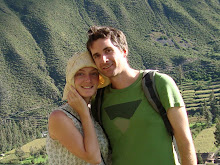 Waving the Sandinista flag with Rachel.
Waving the Sandinista flag with Rachel. The next day we joined hundreds of thousands of people in the main square in melting heat to listen to Daniel Ortega, the president, give his annual speech.
The next day we joined hundreds of thousands of people in the main square in melting heat to listen to Daniel Ortega, the president, give his annual speech.  It was a rousing affair, speaking out against the American intelligence agencies, their participation in the Honduran coup and their setting up military bases in Colombia. He made the distinction between US foreign policy and the US people, which was fortunate for us, as we look like Americans and he even offered some support for Obama. It was a great family atmosphere and most people were there for the day out and the celebrations rather than pinning on every word of his speech. After it was over, the band started up and the sound of thousands of noisy bangers filled the sky.
It was a rousing affair, speaking out against the American intelligence agencies, their participation in the Honduran coup and their setting up military bases in Colombia. He made the distinction between US foreign policy and the US people, which was fortunate for us, as we look like Americans and he even offered some support for Obama. It was a great family atmosphere and most people were there for the day out and the celebrations rather than pinning on every word of his speech. After it was over, the band started up and the sound of thousands of noisy bangers filled the sky.  We joined in, dancing around and were received warmly by the fellow partygoers. We were offered shots of a strong spirit, aguardiente, by a group of lads, and were given a Sandinista flag to wave, by another group, who wanted their photos taken with us. As the crowd dispersed, we made our way back to Belkis' mum's house, which had been turned into a bar for the weekend. We met more entertaining and increasingly drunk Sandinista revellers there and our Rachel was given a t-shirt by Rigoberto, who ended up too drunk to speak, while the American Rachel received a Nicaraguan flag. We headed to a crowded, outdoor basketball court surrounded by bars and stalls where a local Sandinista youth group had set up a stage and organised a musical line-up of impressive quality.
We joined in, dancing around and were received warmly by the fellow partygoers. We were offered shots of a strong spirit, aguardiente, by a group of lads, and were given a Sandinista flag to wave, by another group, who wanted their photos taken with us. As the crowd dispersed, we made our way back to Belkis' mum's house, which had been turned into a bar for the weekend. We met more entertaining and increasingly drunk Sandinista revellers there and our Rachel was given a t-shirt by Rigoberto, who ended up too drunk to speak, while the American Rachel received a Nicaraguan flag. We headed to a crowded, outdoor basketball court surrounded by bars and stalls where a local Sandinista youth group had set up a stage and organised a musical line-up of impressive quality.  With American Rachel, Nick and Belkis waiting for a band to start.
With American Rachel, Nick and Belkis waiting for a band to start. We had a brilliant night listening to some really good, politically charged music, waving our flag and dancing with lots of locals. It was an inspiring and fun day, sharing in the recent history of the country, getting an insight into the importance of politics for the people, and being welcomed so warmly into a giant, friendly and fun-loving community.


























































